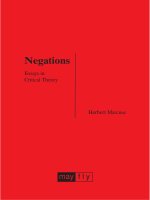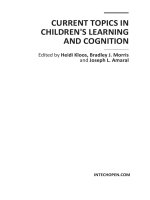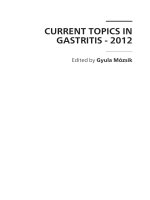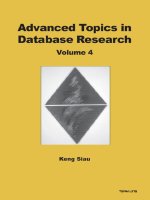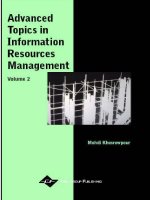Serre j p topics in galois theory
Bạn đang xem bản rút gọn của tài liệu. Xem và tải ngay bản đầy đủ của tài liệu tại đây (623.92 KB, 134 trang )
✐
✐
✐
✐
Topics in Galois Theory
✐
✐
✐
✐
✐
✐
✐
✐
Research Notes in Mathematics
Volume 1
✐
✐
✐
✐
✐
✐
✐
✐
Topics in Galois Theory
Second Edition
Jean-Pierre Serre
Coll`ege de France
Notes written by Henri Darmon
McGill University
A K Peters, Ltd.
Wellesley, Massachusetts
✐
✐
✐
✐
✐
✐
✐
✐
Editorial, Sales, and Customer Service Office
A K Peters, Ltd.
888 Worcester Street, Suite 230
Wellesley, MA 02482
www.akpeters.com
Copyright c 2008 by A K Peters, Ltd.
All rights reserved. No part of the material protected by this copyright
notice may be reproduced or utilized in any form, electronic or mechanical, including photocopying, recording, or by any information storage and
retrieval system, without written permission from the copyright owner.
First edition published in 1992 by Jones and Bartlett Publishers, Inc.
Library of Congress Cataloging-in-Publication Data
Serre, Jean-Pierre.
Topics in Galois theory / Jean-Pierre Serre ; notes written by Henri Darmon.
-- 2nd ed.
p. cm. – (Research notes in mathematics ; v 1)
Includes bibliographical references and index.
ISBN 978-1-56881-412-4 (alk. paper)
1. Galois theory. I. Title.
QA214.S47 2007
512 .32--dc22
2007030849
Printed in Canada
11 10 09 08 07
10 9 8 7 6 5 4 3 2 1
✐
✐
✐
✐
✐
✐
✐
✐
Contents
Foreword
ix
Notation
xi
Introduction
xiii
1 Examples in low degree
1.1 The groups Z/2Z, Z/3Z, and S3 . .
1.2 The group C4 . . . . . . . . . . . . .
1.3 Application of tori to abelian Galois
2, 3, 4, 6 . . . . . . . . . . . . . . .
. . . . . . . . . . . .
. . . . . . . . . . . .
groups of exponent
. . . . . . . . . . . .
1
1
2
6
2 Nilpotent and solvable groups as Galois groups over Q
2.1 A theorem of Scholz-Reichardt . . . . . . . . . . . . . . .
2.2 The Frattini subgroup of a finite group . . . . . . . . . . .
9
9
16
3 Hilbert’s irreducibility theorem
3.1 The Hilbert property . . . . . . . . . . . .
3.2 Properties of thin sets . . . . . . . . . . .
3.3 Irreducibility theorem and thin sets . . . .
3.4 Hilbert’s irreducibility theorem . . . . . .
3.5 Hilbert property and weak approximation
3.6 Proofs of prop. 3.5.1 and 3.5.2 . . . . . . .
.
.
.
.
.
.
.
.
.
.
.
.
.
.
.
.
.
.
.
.
.
.
.
.
.
.
.
.
.
.
.
.
.
.
.
.
.
.
.
.
.
.
.
.
.
.
.
.
.
.
.
.
.
.
19
19
21
23
25
28
31
4 Galois extensions of Q(T): first examples
4.1 The property GalT . . . . . . . . . . . . .
4.2 Abelian groups . . . . . . . . . . . . . . .
4.3 Example: the quaternion group Q8 . . . .
4.4 Symmetric groups . . . . . . . . . . . . .
.
.
.
.
.
.
.
.
.
.
.
.
.
.
.
.
.
.
.
.
.
.
.
.
.
.
.
.
.
.
.
.
.
.
.
.
35
35
36
38
39
v
✐
✐
✐
✐
✐
✐
✐
✐
vi
Contents
4.5
4.6
The alternating group An . . . . . . . . . . . . . . . . . .
Finding good specializations of T . . . . . . . . . . . . . .
5 Galois extensions of Q(T) given by torsion on
elliptic curves
5.1 Statement of Shih’s theorem . . . . . . . . . . . . . . . . .
5.2 An auxiliary construction . . . . . . . . . . . . . . . . . .
5.3 Proof of Shih’s theorem . . . . . . . . . . . . . . . . . . .
5.4 A complement . . . . . . . . . . . . . . . . . . . . . . . .
5.5 Further results on PSL2 (Fq ) and SL2 (Fq ) as Galois groups
6 Galois extensions of C(T)
6.1 The GAGA principle . . . . . . . . . .
6.2 Coverings of Riemann surfaces . . . .
¯ . . . . . . . . . . . . . .
6.3 From C to Q
6.4 Appendix: universal ramified coverings
surfaces with signature . . . . . . . . .
47
47
48
49
52
53
. . . .
. . . .
. . . .
55
55
57
57
. . . .
60
.
.
.
.
.
.
.
.
.
.
.
.
.
.
.
.
65
65
67
70
72
.
.
.
.
.
.
.
.
.
.
.
.
.
.
.
.
81
81
84
85
89
form Tr(x2 ) and its applications
Preliminaries . . . . . . . . . . . . . . . . . . . . . . . . .
The quadratic form Tr (x2 ) . . . . . . . . . . . . . . . . .
Application to extensions with Galois group A˜n . . . . . .
95
95
98
100
. . . . . . .
. . . . . . .
. . . . . . .
of Riemann
. . . . . . .
7 Rigidity and rationality on finite groups
7.1 Rationality . . . . . . . . . . . . . . . . . . . .
7.2 Counting solutions of equations in finite groups
7.3 Rigidity of a family of conjugacy classes . . . .
7.4 Examples of rigidity . . . . . . . . . . . . . . .
.
.
.
.
8 Construction of Galois extensions
rigidity method
8.1 The main theorem . . . . . . . .
8.2 Two variants . . . . . . . . . . .
8.3 Examples . . . . . . . . . . . . .
8.4 Local properties . . . . . . . . . .
.
.
.
.
9 The
9.1
9.2
9.3
43
44
.
.
.
.
of Q(T) by the
.
.
.
.
.
.
.
.
10 Appendix: the large sieve inequality
10.1 Statement of the theorem . . . . . .
10.2 A lemma on finite groups . . . . . .
10.3 The Davenport-Halberstam theorem
10.4 Combining the information . . . . .
.
.
.
.
.
.
.
.
.
.
.
.
.
.
.
.
.
.
.
.
.
.
.
.
.
.
.
.
.
.
.
.
.
.
.
.
.
.
.
.
.
.
.
.
.
.
.
.
.
.
.
.
.
.
.
.
.
.
.
.
.
.
.
.
.
.
.
.
.
.
.
.
.
.
.
.
103
103
105
105
107
✐
✐
✐
✐
✐
✐
✐
✐
Contents
vii
Bibliography
109
Index
119
✐
✐
✐
✐
✐
✐
✐
✐
Foreword
These notes are based on “Topics in Galois Theory,” a course given by
J-P. Serre at Harvard University in the Fall semester of 1988 and written
down by H. Darmon. The course focused on the inverse problem of Galois
theory: the construction of field extensions having a given finite group G
as Galois group, typically over Q but also over fields such as Q(T ).
Chapter 1 discusses examples for certain groups G of small order. The
method of Scholz and Reichardt, which works over Q when G is a p-group
of odd order, is given in chapter 2. Chapter 3 is devoted to the Hilbert
irreducibility theorem and its connection with weak approximation and
the large sieve inequality. Chapters 4 and 5 describe methods for showing
that G is the Galois group of a regular extension of Q(T ) (one then says
that G has property GalT ). Elementary constructions (e.g. when G is a
symmetric or alternating group) are given in chapter 4, while the method of
Shih, which works for G = PSL2 (p) in some cases, is outlined in chapter 5.
Chapter 6 describes the GAGA principle and the relation between the
topological and algebraic fundamental groups of complex curves. Chapters
7 and 8 are devoted to the rationality and rigidity criterions and their
application to proving the property GalT for certain groups (notably, many
of the sporadic simple groups, including the Fischer-Griess Monster). The
relation between the Hasse-Witt invariant of the quadratic form Tr (x2 ) and
certain embedding problems is the topic of chapter 9, and an application
to showing that A˜n has property GalT is given. An appendix (chapter 10)
gives a proof of the large sieve inequality used in chapter 3.
The reader should be warned that most proofs only give the main ideas;
details have been left out. Moreover, a number of relevant topics have been
omitted, for lack of time (and understanding), namely:
a) The theory of generic extensions, cf. [Sa1].
b) Shafarevich’s theorem on the existence of extensions of Q with a given
solvable Galois group, cf. [NSW], chap. IX.
c) The Hurwitz schemes which parametrize extensions with a given Galois group and a given ramification structure, cf. [Fr1], [Fr2], [Ma3].
ix
✐
✐
✐
✐
✐
✐
✐
✐
x
Foreword
d) The computation of explicit equations for extensions with Galois group
PSL2 (F7 ), SL2 (F8 ), M11 , . . ., cf. [LM], [Ma3], [Ma4], [Ml1], . . .
e) Mestre’s results [Me3] on extensions of Q(T ) with Galois group 6 · A6 ,
6 · A7 , and SL2 (F7 ).
We wish to thank Larry Washington for his helpful comments on an
earlier version of these notes.
Paris, August 1991.
H. Darmon
J-P. Serre
For the second edition of these Notes, some corrections have been made,
and the references have been updated.
Paris, June 2004
J-P. Serre
✐
✐
✐
✐
✐
✐
✐
✐
Notation
If V is an algebraic variety over the field K, and L is an extension of K, we
denote by V (L) the set of L-points of V and by V/L the L-variety obtained
from V by base change from K to L. All the varieties are supposed reduced
and quasi-projective.
An is the affine n-space; An (L) = Ln .
Pn is the projective n-space; Pn (L) = (L(n+1) − {0})/L∗ ; the group of
automorphisms of Pn is PGLn = GLn /Gm .
If X is a finite set, |X| denotes the cardinality of X.
xi
✐
✐
✐
✐
✐
✐
✐
✐
Introduction
The question of whether all finite groups can occur as Galois groups of an
extension of the rationals (known as the inverse problem of Galois theory)
is still unsolved, in spite of substantial progress in recent years.
In the 1930’s, Emmy Noether proposed the following strategy to attack
the inverse problem [Noe]: by embedding G in Sn , the permutation group
on n letters, one defines a G-action on the field Q(X1 , . . . , Xn ) = Q(X).
Let E be the fixed field under this action. Then Q(X) is a Galois extension
of E with Galois group G.
In geometric terms, the extension Q(X) of E corresponds to the projection of varieties: π : An −→ An /G, where An is affine n-space over Q.
Let P be a Q-rational point of An /G for which π is unramified, and lift
¯ The conjugates of Q under the action of Gal(Q/Q)
¯
it to Q ∈ An (Q).
are
the sQ where s ∈ HQ ⊂ G, and HQ is the decomposition group at Q. If
HQ = G, then Q generates a field extension of Q with Galois group G.
A variety is said to be rational over Q (or Q- rational) if it is birationally
isomorphic over Q to the affine space An for some n, or equivalently, if its
function field is isomorphic to Q(T1 , . . . , Tn ), where the Ti are indeterminates.
Theorem 1 (Hilbert, [Hi]) If An /G is Q-rational, then there are infinitely
many points P, Q as above such that HQ = G.
This follows from Hilbert’s irreducibility theorem, cf. §3.4.
Example: Let G = Sn , acting on Q(X1 , . . . , Xn ). The field E of Sn invariants is Q(T1 , . . . , Tn ), where Ti is the ith symmetric polynomial, and
Q(X1 , . . . , Xn ) has Galois group Sn over E: it is the splitting field of the
polynomial
X n − T1 X n−1 + T2 X n−2 + · · · + (−1)n Tn .
Hilbert’s irreducibility theorem says that the Ti can be specialized to infinitely many values ti ∈ Q (or even ti ∈ Z) such that the equation
X n − t1 X n−1 + t2 X n−2 + · · · + (−1)n tn = 0
xiii
✐
✐
✐
✐
✐
✐
✐
✐
xiv
Introduction
has Galois group Sn over Q. In fact, “most” ti work: of the N n n-tuples
1
(ti ) with ti ∈ Z, 1 ≤ ti ≤ N , only O(N n− 2 log N ) may fail to give Sn ,
cf. [Ga], [Coh], [Se9].
In addition to the symmetric groups, the method works for the alternating groups An with n ≤ 5, cf. [Mae] (For n ≥ 6, it is not known whether the
field of An -invariants is rational.) Somewhat surprisingly, there are groups
for which the method fails (i.e. An /G is not Q-rational):
• Swan [Sw1] has shown that the field of G-invariants is not rational when
G is a cyclic group of order 47. The obstruction is related to the automorphism group of G which is a cyclic group of order 46 = 2 × 23, and to the
fact that Q(ζ23 ) does not have class number 1 (since h(−23) = 3).
• In [Le] H. Lenstra gives a general criterion for the field of G-invariants to
be rational when G is an abelian group: in particular, he shows that this
criterion is not satisfied when G is cyclic of order 8.
(The above counter-examples are over Q. Counter-examples over C (involving a non-abelian group G) are given by the following result of Saltman [Sa2]: if there is a non-zero α ∈ H 2 (G, Q/Z) such that ResG
H (α) = 0
for all abelian subgroups H generated by two elements, then An /G is not
C-rational. It is not hard to construct groups G satisfying the hypothesis
of Saltman’s theorem: for example, one may take a suitable extension of
abelian groups of type (p, . . . , p).)
It is easy to see (e.g., using the normal basis theorem) that the covering
map
π : An −→ An /G
is generic (or versal) in the sense that every extension of Q (or of any field
of characteristic zero) with Galois group G can be obtained by taking the
π-fibre of a rational point of An /G over which π is unramified. Hence, if
An /G is Q-rational, then the set of all G-extensions of Q can be described
by a system of n rational parameters. Such a parametrization implies the
following property of extensions with Galois group G [Sa1]:
Theorem 2 Assume An /G is Q-rational. Let {pi } be a finite set of
primes, Li extensions of Qpi with Galois group G. Then there is an extension L of Q with Gal(L/Q) = G such that L ⊗ Qpi = Li .
Remark: There is a more general statement, where the Li are allowed to
be Galois algebras, and Q is replaced by a field endowed with finitely many
independent absolute values.
Proof (sketch): Each Li is parametrized by (X (i) ) ∈ An (Qpi ). A “global”
parameter (X) ∈ An (Q) which is sufficiently close to each of the (X (i) ) in
✐
✐
✐
✐
✐
✐
✐
✐
Introduction
xv
the Qpi -topology gives an extension of Q with group G having the desired
local behaviour (Krasner’s lemma). QED.
The cyclic group of order 8 does not satisfy the property of th. 2. Indeed,
if L2 /Q2 is the unique unramified extension of Q2 of degree 8, there is no
L ⊗ Q2 (an easy
cyclic extension L of degree 8 over Q such that L2
exercise on characters, see [Wa]).
One could perhaps extend Hilbert’s theorem to a more general class of
varieties. There is an interesting suggestion of Ekedahl and Colliot-Th´el`ene
in this direction [Ek], [CT] (see §3.5).
Since An /G is not always Q-rational, one has to settle for less:
Question: If G is a finite group, can it be realized as a Galois group of
some Q-regular extension F of Q(T )?
(Recall that “F is Q-regular”
¯ = Q; in what follows we shall usually write “regular”
means that F ∩ Q
instead of “Q-regular”.)
Remarks:
1. If F is a function field of a variety V defined over Q, then F is regular
if and only if V is absolutely irreducible. The regularity assumption is
included to rule out uninteresting examples such as the extension E(T ) of
Q(T ) where E is a Galois extension of Q.
2. If such an F exists, then there are infinitely many linearly disjoint
extensions of Q with Galois group G.
The existence of regular extensions of Q(T ) with Galois group G is known
when G is:
• Abelian;
• One of the 26 sporadic simple groups, (with the possible exception of the
Mathieu group M23 );
•PSL2 (Fp ), where at least one of ( 2p ), ( p3 ), ( p7 ) is −1 [Shih1], [Shih2];
• An , or Sn , cf. [Hi];
• A˜n , cf. N. Vila [Vi] and J-F. Mestre [Me2];
• G2 (Fp ) [Th2], where G2 is the automorphism group of the octonions,
and the list is not exhaustive.
The method for finding F proceeds as follows:
1. Construction (by analytic and topological methods) of an extension
FC of C(T ) with Galois group G.
2. A descent from C to Q. This is the hardest part, and requires that
G satisfies a so-called rigidity criterion.
✐
✐
✐
✐
✐
✐
✐
✐
xvi
Introduction
The outline of the course will be:
1. Elementary examples, and the Scholz-Reichardt theorem.
2. Hilbert’s irreducibility theorem and applications.
3. The “rigidity method” used to obtain extensions of Q(T ) with given
Galois groups.
4. The quadratic form x → Tr (x2 ), and its applications to embedding
problems, e.g., construction of extensions with Galois group A˜n .
✐
✐
✐
✐
✐
✐
✐
✐
Chapter 1
Examples in low degree
1.1
The groups Z/2Z, Z/3Z, and S3
• G = Z/2Z: all quadratic extensions can be obtained by taking square
roots: the map P1 −→ P1 given by X → X 2 is generic (in characteristic
different from 2 - for a characteristic-free equation, one should use X 2 −
T X + 1 = 0 instead).
• G = Z/3Z: A “generic equation” for G is:
X 3 − T X 2 + (T − 3)X + 1 = 0,
with discriminant ∆ = (T 2 − 3T + 9)2 . (In characteristic 3, this reduces to
the Artin-Schreier equation Y 3 − Y = −1/T by putting Y = 1/(X + 1).)
The group G acts on P1 by
σX =
1
,
1−X
where σ is a generator of G. The function
T = X + σX + σ 2 X =
X 3 − 3X + 1
X2 − X
is G-invariant and gives a map Y = P1 −→ P1 /G. To check genericity,
observe that any extension L/K with cyclic Galois group of order 3 defines
a homomorphism φ : GK −→ G −→ Aut Y which can be viewed as a
1-cocycle with values in Aut Y . The extension L/K is given by a rational
point on P1 /G if and only if the twist of Y by this cocycle has a rational
point not invariant by σ. This is a general property of Galois twists. But
this twist has a rational point over a cubic extension of K, and every curve
1
✐
✐
✐
✐
✐
✐
✐
✐
2
Chapter 1. Examples in low degree
of genus 0 which has a point over an odd-degree extension is a projective
line, and hence has at least one rational point distinct from the ones fixed
by σ.
• G = S3 : The map
S3 → GL2 −→ PGL2 = Aut (P1 )
gives a projection
P1 −→ P1 /S3 = P1
which is generic, although the reasoning for C3 cannot be applied, as the
order of S3 is even. But S3 can be lifted from PGL2 to GL2 , and the
vanishing of H 1 (GK , GL2 ) can be used to show that
P1 −→ P1 /S3
is generic.
Exercise: Using the above construction (or a direct argument), show that every
separable cubic extension of K is given by an equation of the form
X 3 + T X + T = 0,
1.2
with T = 0, −27/4.
The group C4
Let K4 /K be Galois and cyclic of degree 4, and suppose that Char K = 2.
The extension K4 is obtained from a unique tower of quadratic extensions:
K ⊂ K2 ⊂ K4 ,
√
√
where K2 = K( ), and K4 = K2 ( a + b ).
√
Conversely, let K2 = K( ) be a quadratic extension of K, where ∈ K ∗
√
is not a square. If a, b ∈ K and K4 = K2 ( a + b ), then K4 may not
be Galois over K (its Galois closure could have Galois group isomorphic to
D4 , the dihedral group of order 8).
Theorem 1.2.1 The field K4 is cyclic of degree 4 if and only if a2 − b2 =
c2 for some c ∈ K ∗ .
Proof: Let G be a group, a non-trivial homomorphism from G to Z/2Z,
and χ a homomorphism from H = Ker to Z/2Z. Let Hχ denote the
kernel of χ.
✐
✐
✐
✐
✐
✐
✐
✐
1.2. The group C4
3
Lemma 1.2.2 The following are equivalent :
(a) Hχ is normal in G, and G/Hχ is cyclic of order 4.
G
(b) CorG
H χ = , where CorH is the corestriction map.
(We abbreviate H 1 (G, Z/2Z) = Hom(G, Z/2Z) to H 1 (G). The corestriction map H 1 (H) −→ H 1 (G) can be defined by
G
(CorG
H χ)(g) = χ(VerH g),
where VerG
H : G/(G, G) −→ H/(H, H) is the transfer.)
The proof that (a) ⇒ (b) is immediate: replacing G by G/Hχ , it suffices
to check that the transfer C4 −→ C2 is onto: but this map is given by
s → s2 .
Now, assume (b). Select s ∈ G − H. The transfer is given by:
−1
mod (H, H).
VerG
H (h) = h · shs
Hence for all h ∈ H:
−1
χ(VerG
) = (h) ≡ 0
H h) = χ(h) + χ(shs
(mod 2).
But if h ∈ Hχ , then χ(h) = 0. It follows that χ(shs−1 ) = 0, so that Hχ is
normal in G. Now, applying the hypothesis to s shows
χ(s2 ) = CorG
H χ(s) = (s) ≡ 1 (mod 2),
so s2 = 1 (mod Hχ ). It follows that G/Hχ is cyclic of order 4, and this
completes the proof of lemma 1.2.2.
¯
Now, let G = GK = Gal(K/K).
The extensions K2 and K4 define
homomorphisms and χ as in the lemma. Via the identification of H 1 (GK )
with K ∗ /K ∗2 , the corestriction map Cor : H 1 (GK2 ) −→ H 1 (GK ) is equal
to the norm, and the criterion CorG
H χ = becomes:
√
N (a + b ) = c2 ,
where c ∈ K ∗ . This completes the proof of th. 1.2.1.
Remark: In characteristic 2, Artin-Schreier theory gives an isomorphism
K/℘K, where ℘x = x2 + x, and the corestriction map correH 1 (GK )
sponds to the trace. Hence the analogue of th. 1.2.1 in characteristic 2
is:
Theorem 1.2.3 Suppose Char K = 2, and let K2 = K(x), K4 = K2 (y),
where ℘x = , ℘y = a + bx. Then K4 is Galois over K and cyclic of degree
4 if and only if Tr (a + bx)(= b) is of the form + z 2 + z, with z ∈ K.
✐
✐
✐
✐
✐
✐
✐
✐
4
Chapter 1. Examples in low degree
Observe that the variables , a, z of th. 1.2.3 parametrize C4 -extensions of
K. In particular, it is possible in characteristic 2 to embed any quadratic
extension in a cyclic extension of degree 4. This is a special case of a
general result: the embedding problem for p-groups always has a solution
in characteristic p (as can be seen from the triviality of H 2 (G, P ) when G
is the absolute Galois group of a field of characteristic p and P is an abelian
p-group with G-action. See for example [Se1].)
The situation is different in characteristic = 2: the criterion a2 −b2 = c2
implies that must be a sum of 2 squares in K: if b2 + c2 = 0, then:
=
ab
b2 + c2
2
+
ac
b2 + c2
2
.
√
Otherwise −1 ∈ K, and any element of K can be expressed as a sum of
2 squares. Conversely, if is the sum of two squares, = λ2 + µ2 , then
setting
a = λ2 + µ2 , b = λ, c = µ,
solves the equation a2 − b2 = c2 . Hence we have shown:
√
Theorem 1.2.4 A quadratic extension K( ) can be embedded in a cyclic
extension of degree 4 if and only if is a sum of two squares in K.
Here is an alternate proof of th. 1.2.4: the quadratic extension K2 can be
embedded in a cyclic extension K4 of degree 4 if and only if the homomorphism : GK −→ Z/2Z given by K2 factors through a homomorphism
GK −→ Z/4Z. This suggests that one apply Galois cohomology to the
sequence:
0 −→ Z/2Z −→ Z/4Z −→ Z/2Z −→ 0,
obtaining:
δ
H 1 (GK , Z/4Z) −→ H 1 (GK , Z/2Z) −→ H 2 (GK , Z/2Z).
The obstruction to lifting ∈ H 1 (GK , Z/2Z) to H 1 (GK , Z/4Z) is given
by δ ∈ H 2 (GK , Z/2Z) = Br2 (K), where Br2 (K) denotes the 2-torsion
in the Brauer group of K. It is well-known that the connecting homomorphism δ : H 1 −→ H 2 , also known as the Bockstein map, is given by
δx = x · x (cup-product). This can be proved by computing on the “universal example” P∞ (R) = K(Z/2Z, 1) which is the classifying space for
Z/2Z. The cup product can be computed by the formula:
α · β = (α, β),
✐
✐
✐
✐
✐
✐
✐
✐
1.2. The group C4
5
where H 1 (G, Z/2Z) is identified with K ∗ /K ∗2 and (α, β) denotes the class
of the quaternion algebra given by
i2 = α, j 2 = β, ij = −ji.
But ( , − ) = 0 (in additive notation), so ( , ) = (−1, ). Hence, δ is 0 if
and only if (−1, ) = 0, i.e., is a sum of two squares in K.
Similarly, one could ask when the extension K4 can be embedded in a
cyclic extension of degree 8. The obstruction is again given by an element
of Br2 (K). One can prove (e.g., by using [Se6]):
Theorem 1.2.5 The obstruction to embedding the cyclic extension K4 in
a cyclic extension of degree 8 is given by the class of (2, ) + (−1, a) in
Br2 (K), if a = 0, and by the class of (2, ) if a = 0.
Hence, when a = 0, the C8 -embedding problem is possible if and only if
the quaternion algebra (2, ) is isomorphic to (−1, a).
There is also a√direct proof of th. 1.2.1.
√ Let K2 and K4 be
√ as before,
with K2 = K( ), K4 = K2 ( a + b ). Let x = a + b
and y =
√
a − b . If Gal(K4 /K) = C4 , then we may choose a generator σ of
Gal(K4 /K) taking x to y, and hence y to −x. Setting
√
c = xy/ ,
√
we have σc = y(−x)/(− ) = c, so c ∈ K ∗ . Also
c2 = x2 y 2 = a2 − b2 ,
and one obtains the same criterion as before. Conversely, if a, b, c, satisfy
the equation a2 − b2 = c2 , one verifies that K4 is a cyclic extension with
Galois group C4 .
Remarks:
1. The minimal polynomial for x over K is
X 4 + AX 2 + B = 0,
where A = 2a, B = a2 − b2 . The condition for a general polynomial of this
form to have Galois group C4 is that A2 − 4B is not a square and that
A2 − 4B
B
∈ K ∗2 .
2. The C4 -extensions are parametrized by the solutions ( , a, b, u) of the
equation
a2 − b2 = u2 ,
✐
✐
✐
✐
✐
✐
✐
✐
6
Chapter 1. Examples in low degree
with u = 0 and not a square. This represents a rational variety: one
can solve for in terms of a, b, and u. Hence the class of C4 -extensions
of Q satisfies the conclusion of th. 2: there are C4 -extensions of Q with
arbitrarily prescribed local behaviour at finitely many places; recall that
this is not true for the cyclic group of order 8.
Exercises:
1. The group C4 acts faithfully on P1 via the map C4 −→ PGL2 which sends
1
1
a generator σ of C4 to
. The corresponding map P1 −→ P1 /C4 is
−1 1
given by z → (z 4 − 6z 2 + 1)/(z(z 2 − 1)). This gives rise to the equation:
Z 4 − T Z 3 − 6Z 2 + T Z + 1 = 0
with Galois group C4 over Q(T ).
1.1 If i ∈ K, show that this equation is generic: in fact, it is equivalent to the
Kummer equation.
1.2 If i ∈
/ K, show that there does not exist any one-dimensional generic family
for C4 -extensions.
1.3 If a C4 -extension is described as before by parameters , a, b and c, show that
it comes from the equation above if and only if (−1, a) = 0 or a = 0.
√
n
2. Assume K contains a primitive 2n -th root of unity z. Let L = K( 2 a) be a
cyclic extension of K of degree 2n . Show that the obstruction to the embedding
of L in a cyclic extension of degree 2n+1 is (a, z) in Br2 (K).
1.3
Application of tori to abelian
Galois groups of exponent 2, 3, 4, 6
A K-torus is an algebraic group over K which becomes isomorphic to a
product of multiplicative groups Gm × . . . × Gm over the algebraic closure
¯ of K. If this isomorphism is defined over K, then the torus is said to be
K
split.
Let T be a K-torus and denote by X(T ) its character group,
X(T ) = HomK¯ (T, Gm ).
It is well known that X(T ) is a free Z-module of rank n = dim T endowed
with the natural action of GK . The functor T → X(T ) defines an antiequivalence between the category of finite dimensional tori over K and the
category of free Z-modules of finite rank with GK action.
A split K-torus is clearly a K-rational variety; the same holds for tori
which split over a quadratic extension K of K. This follows from the
classification of tori which split over a quadratic extension (whose proof we
shall omit - see [CR]):
✐
✐
✐
✐
✐
✐
✐
✐
1.3. Application of tori to abelian Galois groups of exponent 2, 3, 4, 6
7
Lemma 1.3.1 A free Z-module of finite rank with an action of Z/2Z is a
direct sum of indecomposable modules of the form :
1. Z with trivial action.
2. Z with the non-trivial action.
3. Z × Z with the “regular representation” of Z/2Z which interchanges the
two factors.
The corresponding tori are :
1. Gm
2. A “twisted form” of Gm , which corresponds to elements of norm 1 in
(3) below.
3. The algebraic group RK /K Gm obtained from Gm /K by “restriction of
scalars” to K ( cf. §3.2.1).
It is not difficult to show that the three cases give rise to K-rational varieties, and the result follows.
If G is a finite group, the group G of invertible elements of the group
algebra Λ = K[G] defines an algebraic group over K. In characteristic 0,
we have
¯
G
GLni over K,
where the product is taken over all irreducible representations of G and the
ni denote the dimensions of these representations.
In particular, if G is commutative, then G is a torus with character
ˆ where G
ˆ = HomK¯ (G, Gm ). Therefore, G splits over the field
group Z[G],
generated by the values of the characters of G. There is an exact sequence
of algebraic groups:
1 −→ G −→ G −→ G/G −→ 1,
and the covering map G −→ G/G is generic for extensions of K with Galois
group G. If G is of exponent 2,3, 4 or 6, then G splits
over a quadratic
√
extension, since the characters values lie in Q, Q( 3), or Q(i). By the
previous result, G - and hence a fortiori G/G - is Q-rational. So the abelian
groups of exponent 2,3,4 or 6 yield to Noether’s method (but not those of
exponent 8).
Exercise: Show that all tori decomposed by a cyclic extension of degree 4 are
rational varieties, by making a list of indecomposable integer representations of
the cyclic group of order 4 (there are nine of these, of degrees 1, 1, 2, 2, 3, 3, 4, 4, 4).
See [Vo2].
✐
✐
✐
✐
